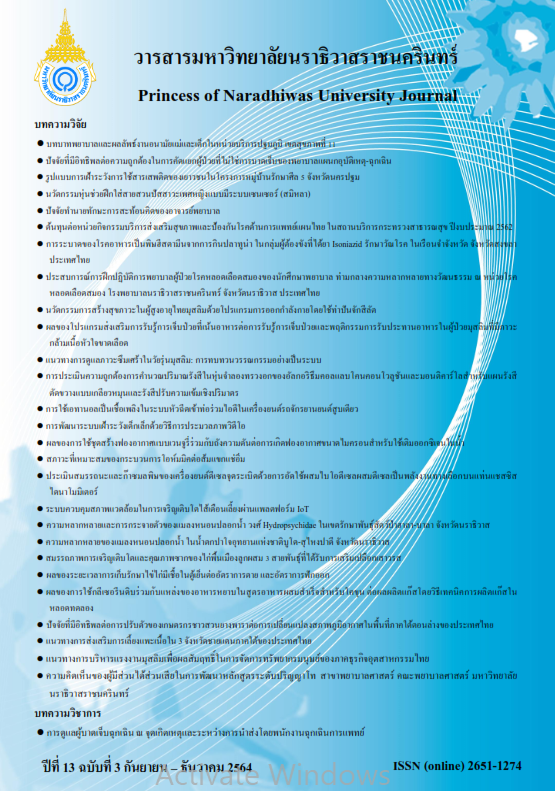Innovation of Female Urinary Catheterization Training Mannequin with Sensor System (Samila)
Keywords:
Innovation, Female urinary catheterization, Training mannequin, Sensor systemAbstract
The purpose of this research and development were 1) to create and develop a female urinary catheterization training mannequin with sensor system (Samila) and 2) to evaluate the effectiveness of the training mannequin. The study was divided into two phases as follows: 1) the design and development of the female urinary catheterization training mannequin with sensor system consisting of need assessment, concepts and literature review, the training mannequin creation, tryout, and improvement; and 2) the evaluation of the effectiveness of the training mannequin. Population was 72 nursing students studying in the third year, academic year of 2019. The instrument used in this research was the censored female urinary catheterization training mannequin which its IOC was ranged from .67 to 1.00, and the Cronbach’s alpha coefficient was equal to .91. Data were analyzed by paired t-test. The results of this study revealed as follows:
- The female urinary catheterization training mannequin with sensor system (Samila) was made from natural latex and synthetic latex resin. Its appearance is a wooden box with anatomical pads attached to the female genitalia. The box was made from plastwood, which is lightweight, durable and non-wet. The interior of the mannequin contains a uterus and a vagina installed inside the mannequin by connecting to the clitoris plate. There is a simulated bladder that can actually be filled with artificial urine, and flow through the catheter. There is a loud sound when the catheter is inserted in the vagina.
- The effectiveness of female urinary catheterization training mannequin with sensor system (Samila) had a statistical significantly higher mean score than the original mannequin at the .001 level (p<.001). After using the training mannequin, 100% of the nursing students could practice inserting a female urinary catheter correctly.
Therefore, Boromarajonani College of nursing, Songkhla should encourage students to use the developed training mannequin (Samila) for those who practice on ward for the first time or those who need to practice in nursing laboratory, as well as students who want to bring the mannequin back to their dormitory for practicing in order to build their confidence and to perform correctly in inserting a female urinary catheter before going on ward.
References
Chotiban, P., Nawsuwan, K., Nontaput, T., & Rodniam, J. (2013). Innovation of Assisted Models for Practicing Basic Nursing Skills. Princess of Naradhiwas University Journal, 5(3), 1-12.
Faculty of Medicine Siriraj Hospital, Mahidol University. (2016). Outstanding innovation Star Rating Project of the Year 2014.Quality Development Faculty of Medicine Siriraj Hospital Mahidol University.Bangkok. (In Thai).
Hair, F.J., Black, C.W., Babin, J.B., & Anderson, E.R. (2010). Multivariate Data Analysis (7th ed). New Jersey: Pearson Education.
Kheokao, J., Yingrengreoung, S., & Krirkgulthorn, T. (2014). Uses of Online Social Media in Nursing Education. University of the Thai Chamber of Commerce Journal Humanities and Social Sciences, 34(4), 219-235.
Kumkong, M., & Nasae, J. (2020) Risk Management in Nursing Practicum. The Southern College Network Journal of Nursing and Public Health, 7(3), 10-22
Kunaviktikul, W. (2015). Teaching and learning in the discipline of nursing in the 21st century. Nursing Journal, 4(2), 152-156.
Lertlum, L., Tanasansutee, C., & Panawatthanapisuit, S. (2019). DevelopmentofaSimulation-Based Learning Model. The Southern College Network Journal of Nursing and Public Health 6(special), 43-58.
Pheeraphan, N. (2014). Development of Information and Communication Technology Usage Model for 21stCenturyLearning Skills in Higher Education. Journal of Education, Prince of Songkla University, 25(3), 19-34.
Ruengrong, P., Jiravarapong, B., Manyum, W., Somyaron, W., Muendet, S., & Srisurat, C. (2014). Educational Technologyvs Thai Teachers in 21st Century. Panyapiwat Journal, 5(Special Issue), 195-207.
Saraketrin, A., Rongmuang, D., & Chantra, R. (2019). Nursing Education in the 21st Century: Competencies and Roles of Nursing Instructors. Journal of the Royal Thai Army Nurses, 20(1), 12-20.
Stauffer, B. (2020). What Are 21st Century Skills?.Retrieved September 23, 2020 from https://www.aeseducation.com/blog/what-are-21st-century-skills
Wangsookpaisal, A., Sawas-Chootor, P., & Wongsuttutham, S. (2017). Instruction in Nursing for Students’ Freedom. Journal of Nursing and Health Care, 35(3), 6-14.




